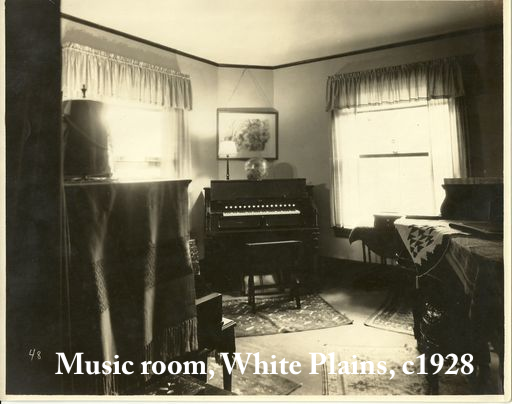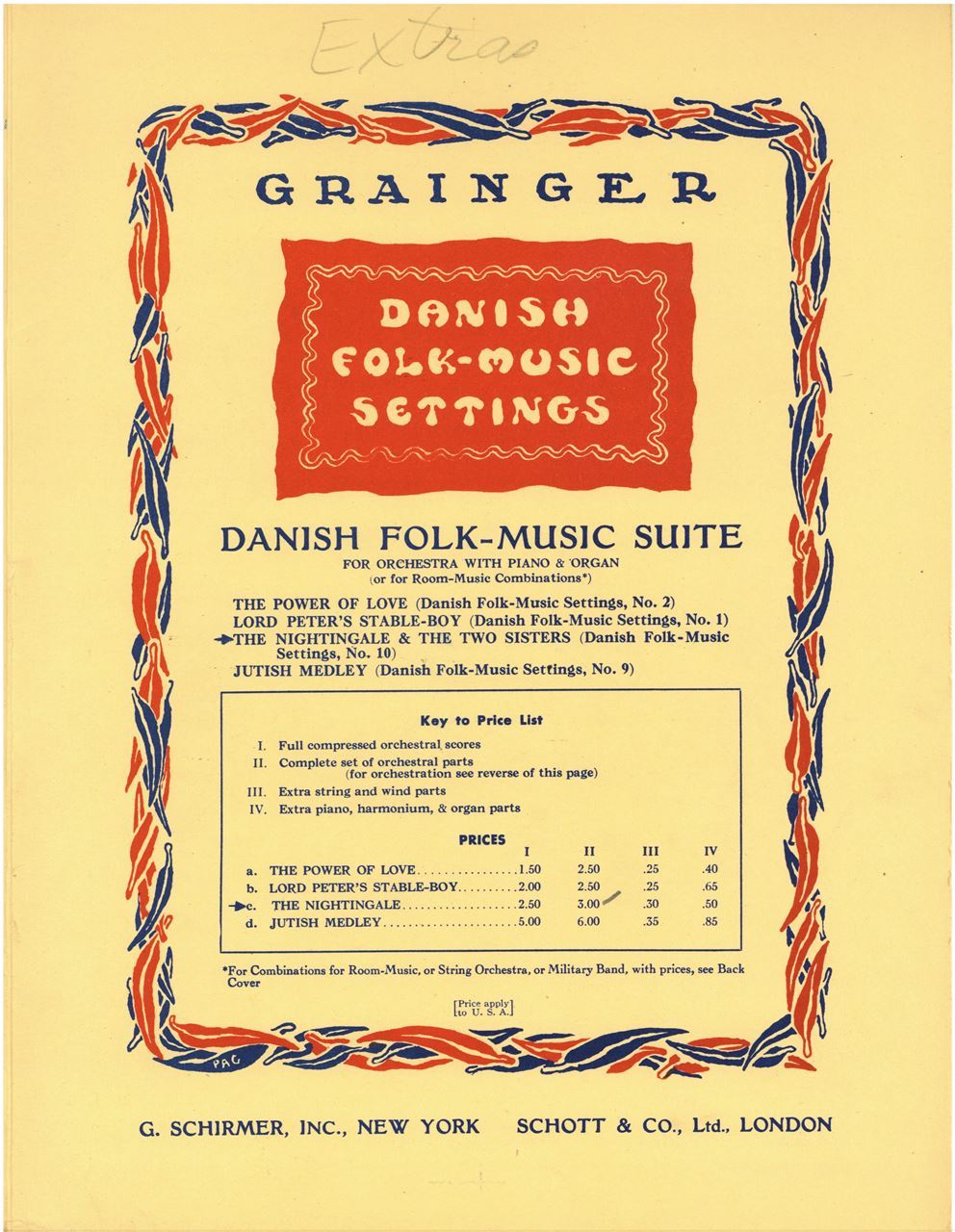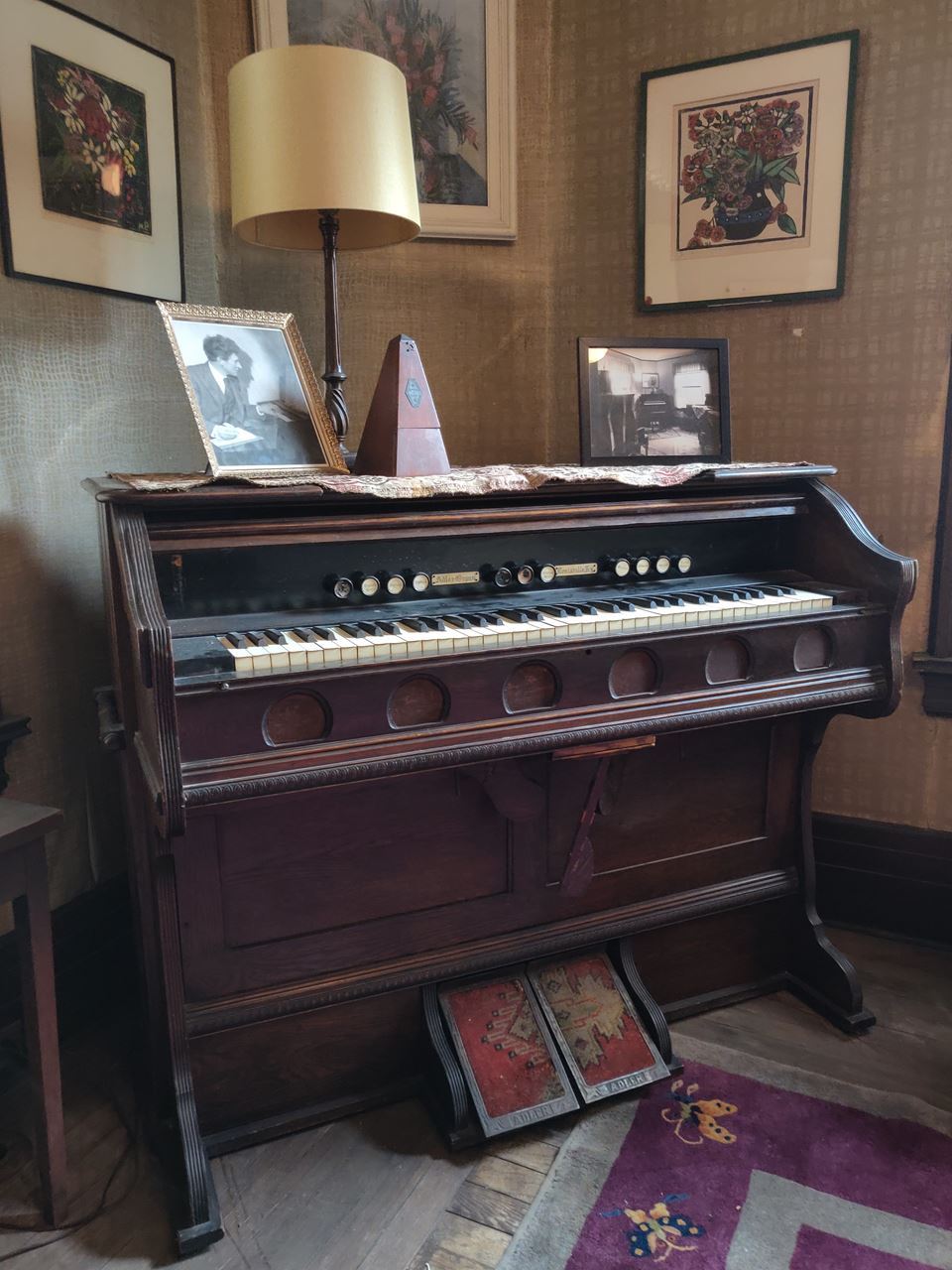
Percy Grainger used three harmoniums that we know of, a Mustel Model 4 (left mysteriously at the Sydney Conservatorium in March, 1935 after his concerts there and destined to live in the basement of Verbrugghen Hall for 80 years), an American-built Estey at 7 Cromwell Place, sent to the Grainger Museum in Melbourne after he died, and the restored instrument currently in the house, an Adler (serial #107256, from 1910) built by the Adler Organ Company of Louisville, Kentucky.
Andrew Robson, in an interesting online article from 2014, describes the intriguing Mustel and Grainger’s 1935 appearances in Sydney during a two-year tour of Australia and New Zealand, also mentioned in Percy Grainger by John Bird (p. 208).
 In his article, “Delius Hostile to Harmonium Parts in my Chamber Music Scores,” Grainger describes the harmonium as “. . . the most essential of all chamber music instruments.” Gillies/Pear/Carroll, Self-Portrait of Percy Grainger , Oxford U. Press, 2006. (“harmonium, use of” 195-96, 199 (p. 196).
In his article, “Delius Hostile to Harmonium Parts in my Chamber Music Scores,” Grainger describes the harmonium as “. . . the most essential of all chamber music instruments.” Gillies/Pear/Carroll, Self-Portrait of Percy Grainger , Oxford U. Press, 2006. (“harmonium, use of” 195-96, 199 (p. 196).
Certainly the instrument entered the pantheon after being the inspiration for “The Immovable Do”; but Grainger used it as a specific option in The Old Woman at the Christening, Youthful Suite, Youthful Rapture, The Peora Hunt, Mowgli’s Song Against People, Harvest Hymn, The Fall of the Stone, The Beaches of Lukannon, and potentially (wherever there is an organ part) in Danish Folk-Music Suite, the orchestra version of Marching Song of Democracy, Hill Song #1, The Immovable Do, and English Dance. The larger instruments can sound like a pipe organ, and were an attractive alternative to pipe organs in small churches; or, chameleon-like, the harmonium can disappear into the fabric of sound supporting the harmonies. Click here for a list of Grainger’s works with harmonium compiled by Barry Peter Ould.
The harmonium, the instrument itself, also became raw material for Grainger’s experiments in “Free Music” as he used and reused parts to create new instruments.
Background:
“The name “Harmonium” was patented in 1842 by Alexandre François Debain (1809-1877) of Paris. It was for a keyboard instrument which used pressurized air from bellows pumped by two foot pedals to produce sound from free-reeds (the same method of sound production found in the accordion and harmonica) creating an instrument which possessed the tonal qualities of a pipe organ and the expressive control of a string instrument. (full article)
 Walter Piston, in his bible, Orchestration, has only a slight paragraph on the harmonium, noting its use in small orchestras to make up for deficiencies in wind tone. Very seldom used in orchestras, much less an opera pit, Richard Strauss uses the harmonium in the “Vorspiel” of Ariadne auf Naxos at Reh #4 to blend the sound of the chamber-size ensemble, sustaining the harmonies and freeing the individual winds to more elaborate parts. Then, at Reh #10, it accompanies, in a humorous way, the dialogue between the Music Teacher (sung) and the Landlord (spoken.) The sound of the harmonium, similar to an accordion, was instantly recognizable and familiar as a domestic instrument.(Click here for a very thorough demonstration of a Mason + Hamlin 61-note “Liszt Organ:”)
Walter Piston, in his bible, Orchestration, has only a slight paragraph on the harmonium, noting its use in small orchestras to make up for deficiencies in wind tone. Very seldom used in orchestras, much less an opera pit, Richard Strauss uses the harmonium in the “Vorspiel” of Ariadne auf Naxos at Reh #4 to blend the sound of the chamber-size ensemble, sustaining the harmonies and freeing the individual winds to more elaborate parts. Then, at Reh #10, it accompanies, in a humorous way, the dialogue between the Music Teacher (sung) and the Landlord (spoken.) The sound of the harmonium, similar to an accordion, was instantly recognizable and familiar as a domestic instrument.(Click here for a very thorough demonstration of a Mason + Hamlin 61-note “Liszt Organ:”)
Around the turn of the century much more elaborate reed organs were developed. Designated “Kunstharmonium,” (Art Harmonium) the instrument could be registered in sophisticated ways, with a couple of keyboards and the possibility of splitting keyboards from side to side into melodic and accompanying sounds, and with espressivo swell boxes controlled with the knees. Some even incorporated piano or bell sounds. Click here for the Kunstharmonium performance played by Jan Hennig.
The blending quality of many of the rich reed registrations were made use of by Arnold Schoenberg and his students for his “Verein für musikalische Privataufführungen” concerts. These ground-breaking private concerts were critic-free chances to hear new music and recent, even unheard, Bruckner and Mahler symphonies. Condensed orchestrations by Berg, Webern, and other Schoenberg pupils were made and performed. At a fundraiser, Strauss waltzes were arranged for string quartet, piano and harmonium; Mahler’s Fourth Symphony was arranged by Erwin Stein for Soprano and 12 players: flute (doubling piccolo) Oboe (doubling English Horn) two Clarinets, 4-hand piano, strings, some percussion and harmonium. There are several recordings of this available today.
Notably, in 1925 (15 years after the premiere of the opera but at the beginning of the all consuming German film industry,) a silent film of Der Rosenkavalier was made, written by von Hoffmanstal and arranged by Strauss with provision for a large, live orchestra accompaniment, without singers.
All movie theaters had live accompaniments, and large theaters in metropolitan areas had resident orchestras. The then brand-new Eastman Theater in Rochester had two orchestras: a pit orchestra for accompanying the wildly popular silent films shown many times a day, and a larger one (which later became the Rochester Philharmonic) for entertainment in between films and for the main evening shows. Large production companies would send around the scores and parts to music written for the specific movies, with flexible scoring (“pit arrangements”) which could be adapted for the particular theater (cues written in all parts to make substituting easy.)
The “Salon Orchestra Version” authorized by Strauss and published by Fürstner “distilled” the orchestration down from 100 to 13 players: flute, oboe, 2 trumpets, trombone, 2 violins, cello, bass, piano, some percussion, and harmonium.
Eric Culver, April 14, 2020